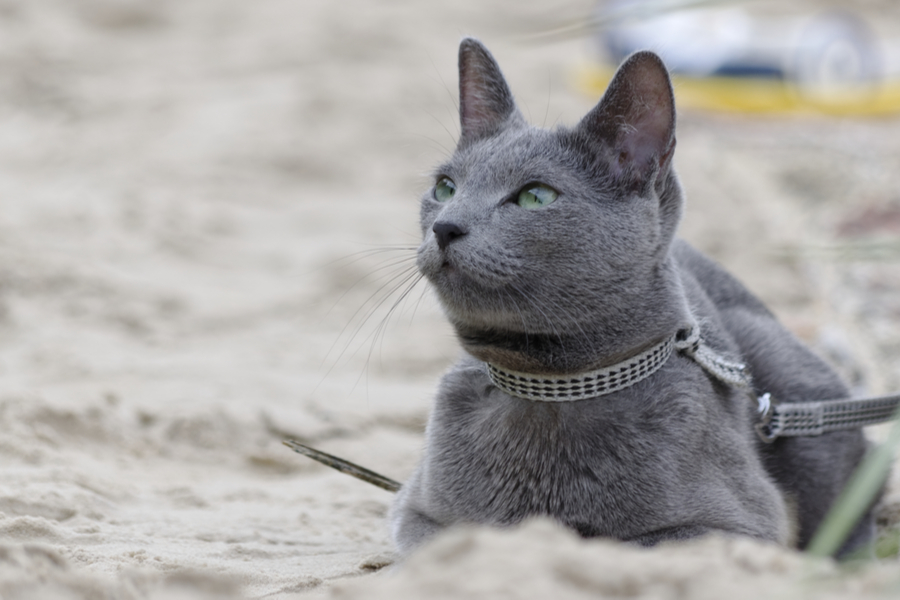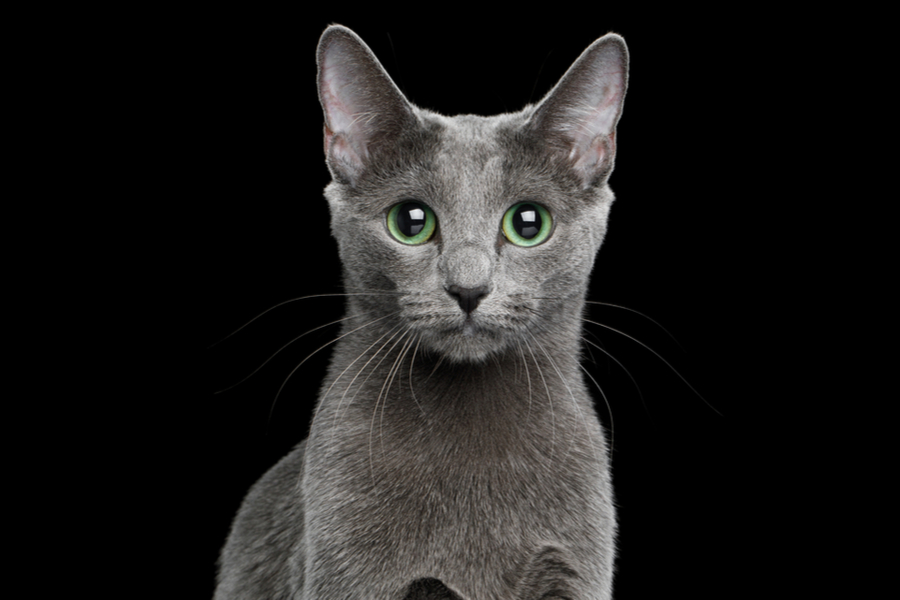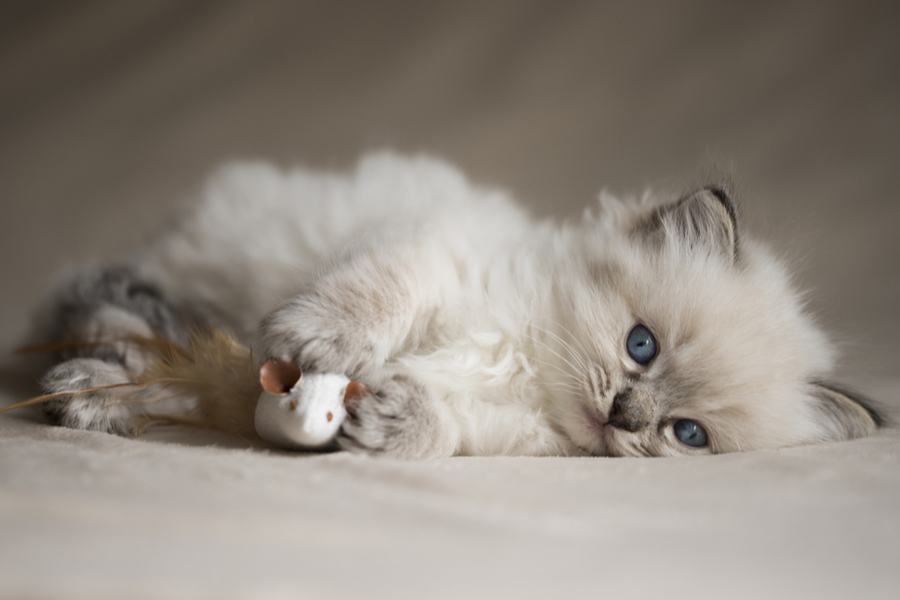Average sizes and life expectancy for this breed:
Ragdoll cats are large, semi-long haired cats with gorgeous blue eyes. They are described as affectionate and loving cat breeds as they get along well with children, dogs, and other pets. This strong and confident cat breed can blend effortlessly into the eventful contemporary household.
Ragdolls can be seen as a relaxed and happy cat. They often go limp in your arms when held and flop like a stuffed doll when snuggled. Usually, a Ragdoll cat has a laidback disposition. They are loving, calm and docile. They are not talkative either, but they have their playful moments. Ragdoll kittens and young adults are particularly high-spirited.
The sweet-looking Ragdoll cats are the second most popular cat breed registered with the Governing Council of the Cat Fancy (GCCF). It ranks even higher with owners. For many, Ragdoll cats have it all – big expressive blue eyes, a sweet face, silky coat, and heart-melting soul. In return for their loyalty, the only thing the Ragdoll asks is to be part of your world.
Ragdolls enjoy being around people. They have a unique 'smiley' expression that cat lovers adore. This cat breed is known to be easy going and affectionate. The more love and attention you give, you will receive it back and more. They are also tolerant of other animals and children. They are often compared to dogs because of their friendliness and intelligence. They can also be trained to play fetch.
Ragdoll cats are relative newcomers to the cat world. But thanks to their sweet and kind demeanour and charming looks, they are fast becoming one of the most popular cat breeds worldwide. They are large-sized cats that have semi-long hair and beautiful blue eyes.
See available kittens




The history of Ragdoll cats makes a strange story. But compared with other cat breeds, it is well documented and can be identified to a Californian breeder named Ann Baker.
According to Ann Baker, she used to borrow a cat that looked very much like a Black Persian from her neighbour named Blackie for breeding purposes. Blackie had no registered pedigree, and its mother, Josephine, was an unregistered white longhair. Allegedly, Josephine used to give birth to kittens with a very unbalanced temperament until she had a road accident.
After her treatment at a local animal hospital, Josephine’s kittens now had a different character and were unexpectedly pleasant and very relaxed. Ann Baker was very curious and interested in this character change. Using other interrelated cats owned by her neighbour, together with her Persian cats, she then bred and produced the first Ragdolls in 1963 with the laid-back temperament that she was looking for.
The development of this new cat breed reached an unusual milestone when Ann Baker trademarked the name 'Ragdoll.' Those who wish to breed them could only do so by a franchise basis through her own International Ragdoll Cat Association. However, in 2005, the trademarking of the 'Ragdoll' name in the US was finally dropped when it was not renewed.
In 1981, the first Ragdolls were brought to the United Kingdom. Today, these gorgeous looking cats are well-known for their sweet, good-natured temperaments that made them a fast-becoming popular companion and family pet. With this, more and more Ragdolls are being registered yearly with the GCCF as their popularity continues to rise.


Ragdoll cats are one of the largest cat breeds, as recognized by various feline organisations worldwide. It takes up to four years for this cat breed to reach full maturity. A fully developed male will weigh from 7 to 9 kilogram while their female counterpart weighs 4.5 to 7 kilograms. These docile cats have long bodies with strong boning to match. They have a soft and sweet expression highlighted by their large eyes.
The Ragdoll cat breed is large, powerful, and impressive with unique markings. However, the cat breed is extremely calm and laid back, giving the floppy ragdoll impression. Their broad head has a flat top and is wide between the ears. Their deep blue eyes are large as well.
A Ragdoll cat's body is long and muscular with a broad chest, short neck, and sturdy legs. Their paws are large, round and tufted, and the tail is long and bushy. Moreover, the Ragdoll cat's coat is dense, silky and medium to long length.
Ragdoll cats are blue-eyed and pointed – darker face, legs, ears, and tail. They are lighter coloured on the body with a fixed contrast between body and point colour. Their colours may be blue, seal, lilac, chocolate, cream, red, fawn, or cinnamon. In addition, they may be tortie or have lynx stripes or tabby markings.
There are three possible patterns:
Ragdoll cats typically go through several growth spurts as they age, and this will continue on and off until they are four years old. Do not be deceived by the fat on their belly – a trait of the cat breed. Make sure they always have ample food available to support their growth until you are sure they have reached their full size.
Ragdoll cats are distinguished for collapsing into the arms of anyone who holds them, even if they are cradled on their back. They adore their owners, greeting them, following them around the house, and jumping into a lap or cuddling in bed whenever given a chance. They learn to come when called or to get toys that are thrown for them.
The word most repeatedly used to describe Ragdolls is quiet, but that does not mean they are sluggish and inactive. They love to play with their toys and join in any family activities. With positive support in the form of praise and treats when they do something you like, Ragdolls learn fast. They can also pick up tricks and good behaviours such as using a scratching post. Ragdolls love food and attention equally, so they will remind you when it's mealtime or ask for petting in a small, sweet voice but are not overly vocal.


Ragdolls originally got their name from their inclination to go limp when picked up. While this is not always the case, they are generally happy to be held. Their trusting nature means they should be introduced with extra care to existing cats or dogs, who might not be quite as calm and mild. Some owners choose to keep them indoors for similar reasons.
While Ragdoll cats are known to be calm and easy-going, they still do like to play. So, encourage them by investing in catnip toys, balls, feather wands and other interactive toys that are good for bonding time, exercise and playing. A cat tree is also ideal as a good scratching post and a resting place in one.
Adaptable to most environments, Ragdoll cats are playful without being excessively active. It is typically easy to train them to use a litter tray as they will respond best to positive reinforcement. You can also teach your Ragdoll to play fetch, thanks to the cat breed's puppyish personality.
The Ragdoll's coat requires regular grooming to keep it in good condition. It is best to use a wide-toothed metal comb to eliminate dead hair and prevent matting. If they are not groomed and develop extremely matted fur, they may need to be shaved. Be sure to comb a Ragdoll’s armpit area in particular, as tangles can be common here during shedding season.
Unlike some cat breeds, Ragdolls have a single coat without an undercoat. This can make them a better match for some people with allergies. However, they are not hypoallergenic. The absence of an undercoat additionally makes shedding more controllable.
Their nails should be trimmed once a month. Your groomer or vet can teach you how to clip your Ragdoll cat's claws properly. For their dental hygiene, it is best to do weekly brushing to keep your Ragdoll cat's teeth free from plaque buildup and prevent the risk of periodontal disease.
For their eyes, use a damp cloth to wipe the corner of the eyes to remove any discharge. Just make sure to use separate areas of the cloth for each eye to prevent spreading infection. Check and clean their ears weekly. Avoid using cotton swabs as it may damage the interior of their ears. Ask for your vet's advice on what pet product to use to clean your Ragdoll cat's ears to prevent ear mites that may lead to an infection.
Always make sure to keep your Ragdoll cat's litter box clean. It will help keep their coat and paws clean as well. Also, because Ragdoll cats are known for their size as they age, it’s best to purchase a super-sized litter box to ensure that they have ample room to turn around.


Ragdoll cats have an average life expectancy of twelve to fifteen years, providing they are given a high-quality diet and proper care. However, there are a few hereditary health problems that may affect a Ragdoll cat include the following:
Because of this, only buy a Ragdoll from a registered breeder who runs DNA health checks on their cats. This will give you peace of mind that they do not have genetic conditions and increase the likelihood of them living a long and healthy life.
In addition, make sure that your Ragdoll cat gets plenty of interactive playtime to help prevent weight gain. Note that it is common for them to have a thin layer of fat around their lower abdomen, but too much can lead to obesity. Feel their spine and ribcage as these are the best places to check their weight and condition.
The Ragdoll is perfectly suitable for family life. They rarely extend their claws when playing, and they typically do not mind playing, riding in a baby stroller, or being a guest at a tea party. Still, it is advisable to supervise young children to make sure they don't annoy the cat. And with a cat of this size, it's essential to teach children how to support the cat when picking them up and carrying them. Remember to never hold a Ragdoll cat with the hind end hanging down.
Ragdolls are happy to live with other cats and cat-friendly dogs, in fact, they welcome the additional company. Even so, introduce pets gradually and in controlled circumstances to guarantee that they learn to get along together.


We can connect you with Breeders that are specialized in this particular breed.
See available kittens
Myanmar
Size : Medium
Coat : Long
Registration : GCCF, TICA, CFA, FIFe
Vocality : Low
Hypoallergenic : No
Grooming : Everyday

Iran
Size : Medium
Coat : Long
Registration : GCCF, TICA, CFA, FIFe
Vocality : Low
Hypoallergenic : No
Grooming : Twice a Week

Russia
Size : Medium
Coat : Long
Registration : GCCF, TICA, CFA, FIFe
Vocality : Medium
Hypoallergenic : Yes
Grooming : Twice a Week

United States of America
Size : Large
Coat : Long
Registration : GCCF, CFA
Vocality : Low
Hypoallergenic : No
Grooming : Twice a Week


Need some advice?
Whether you're a first time pet owner, an experienced pet owner, a new or long-time breeder, or just curious about pets, we've got you covered!

January 17, 2024
What Is The Personality Of Russian Blue Cats?
Russian Blue cats are most known for their distinctive shimmery blue-silver coat and piercing green eyes. However, this breed’s calm and gentle temperament is what makes them shine the most in the feline world.

January 17, 2024
10 Facts About Russian Blue Cat Breed
Russian Blues are one of the most aesthetically stunning cat breeds, with a gorgeous plush silvery coat and vibrant green eyes. However, it’s not only their appearance that is beautiful; their nature is too.

January 17, 2024
How To Choose The Right Cat Breed for You
Cats can make the most fantastic animal companions; they are adorable, friendly, and loving. However, not all felines are created equal. There are many different breeds, of which each has its unique personality traits.
Need some help?
Contact us to speak to our friendly advisor, who will gladly help you find your dream pet!



We are registered in England and Wales under registration number 12568840,
and our registered office is at 58-60 Kensington Church Street, W8 4DB London, England.
© 2023 The Pedigree Paws